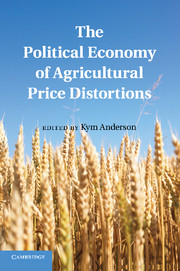Book contents
- Frontmatter
- Contents
- List of Figures
- List of Tables
- Contributors
- Foreword
- Preface
- Abbreviations and Acronyms
- PART ONE Introduction
- PART TWO CONCEPTUAL FRAMEWORKS AND HISTORICAL ORIGINS
- THREE Political Economy of Agricultural Distortions
- FOUR Special Interests versus the Public Interest in Policy Determination
- FIVE Anglo-French Trade, 1689–1899
- SIX Agricultural Protection Growth in Europe, 1870–1969
- SEVEN Determinants of United States Farm Policies
- EIGHT Agricultural Distortions in the Transition Economies of Asia and Europe
- Part Three Political Econometrics: the Past Fifty Years
- Appendix: Coverage and Distribution of Assistance across Countries and Products, 1955–2007
- Index
- References
SIX - Agricultural Protection Growth in Europe, 1870–1969
Published online by Cambridge University Press: 05 July 2011
- Frontmatter
- Contents
- List of Figures
- List of Tables
- Contributors
- Foreword
- Preface
- Abbreviations and Acronyms
- PART ONE Introduction
- PART TWO CONCEPTUAL FRAMEWORKS AND HISTORICAL ORIGINS
- THREE Political Economy of Agricultural Distortions
- FOUR Special Interests versus the Public Interest in Policy Determination
- FIVE Anglo-French Trade, 1689–1899
- SIX Agricultural Protection Growth in Europe, 1870–1969
- SEVEN Determinants of United States Farm Policies
- EIGHT Agricultural Distortions in the Transition Economies of Asia and Europe
- Part Three Political Econometrics: the Past Fifty Years
- Appendix: Coverage and Distribution of Assistance across Countries and Products, 1955–2007
- Index
- References
Summary
Over the past decades, European countries spent more than 50 billion euros annually on subsidizing their farmers and protecting them against imports from other countries. This is not only the case in countries belonging to the European Union (EU), but also in countries such as Iceland, Norway, and Switzerland that have highly protected agricultural sectors. The most important form of government intervention in European agricultural markets is undoubtedly the Common Agricultural Policy (CAP) of the EU. While the EU has since reformed the CAP, the introduction of the CAP between 1962 and 1967 created a highly protectionist and distortive system of government intervention in agricultural markets across a large part of the continent.
How things changed in a century: 100 years earlier, Europe was characterized by free trade in agricultural and food products. The abolishment of the Corn Laws in 1846 signaled the end (or rather the beginning of the end – see Nye 2010) of farm import protection in England; and the English-French trade agreement of 1860 was the start of a series of trade agreements across Europe, effectively removing most trade constraints in agricultural markets.
These contrasting observations beg several questions: How and when did this change in policy occur? Why did it occur? Which events triggered these dramatic changes in policy preferences in Europe over the course of a century, and what were the fundamental causes that made them possible? These are the questions that this chapter tries to answer.
- Type
- Chapter
- Information
- The Political Economy of Agricultural Price Distortions , pp. 141 - 161Publisher: Cambridge University PressPrint publication year: 2010
References
- 7
- Cited by



